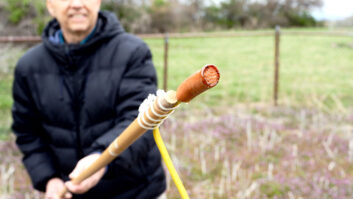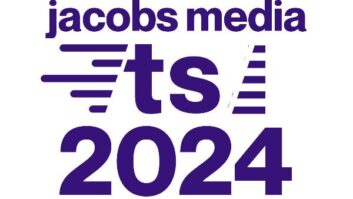(click thumbnail)Fig. 1: Make a good first impression with a clean remote van. Wayne Coleman, here with his spouse Jean, maintains seven vehicles.It’s the season for remote broadcasts, and I thought I’d share some ideas from Market Engineer Jon Bennett and his staff at the Cox facility in Richmond, Va.
Perhaps the group’s best asset is the team of Wayne and Jean Coleman (Fig 1). Wayne is the remote events coordinator for the four-station group. He maintains seven vehicles, often with Jean’s assistance.
Want to make a great impression on the client? “Show up with a sparkling station vehicle!” says Wayne. Just as the receptionist is the “director of first impressions” who influences any callers or visitors, a station vehicle pulling into the remote location can spark enthusiasm for the client.
If you don’t have someone to maintain the remote vehicles – and this is not the chief engineer – get a summer intern or paid summer help. The efforts will return many dividends. Where do you find someone like this? Try an auto mechanic’s school or a car dealership. Just like you are “in love with radio,” this person should be “in love with vehicles.”
(click thumbnail)Fig. 2: Secure the rack to the roof and free up storage space underneath.
Jon Bennett’s cluster in Richmond has Wayne. He not only maintains the vehicles – changing oil, maintaining fluid levels, license renewals and registrations – but he also keeps track of the remote gear. Checking out cables and equipment before each remote, Wayne’s efforts minimize DOA equipment, which would cost the station money in lost remote revenue. It’s quick to see that his services are not an expense, but more like insurance that the remote will run without a hitch.
When it comes to maintaining remote vehicles, it helps to be organized and space-conscious. Fig. 2 shows how the remote rack was bolted to the roof supports of the van. This got the rack up off the floor, freeing storage space below.
The Mackie mixer is even on hinges, and can be folded up into the bottom of the rack for transport, then lowered into operating position once at the event; see Fig. 3. To the right in that photo is a folding utility table that can be transported easily now that additional storage space has been created.
Wayne also recommends a supply of different length bungee cords; they do a great job of keeping everything secure.
If you’re planning a new vehicle, keep in mind how it will be used. The Cox crew in Richmond moved the hydraulic mast control components from the center of the van to the side wall, thus creating additional storage space. There’s even more space under the equipment rack.
(click thumbnail)Fig. 3: The folding Mackie Mixer provides additional storage space.
Thanks to Jon Bennett and Wayne and Jean Coleman for sharing how they do remotes “down south.” Jon Bennett can be reached at [email protected].
. . .
Here’s a neat addition to an equipment rack: lights that go on automatically when the rear door is opened.
You can now buy white LEDs that are so bright they are visible in sunlight. Paul Sagi, a contract engineer in Kuala Lumpur, writes that a string of these can be run along the inside of the equipment rack and tied to a door-mounted magnetic proximity switch, the kind used in alarm systems.
The LEDs are powered with a low-voltage AC/DC adapter. They provide a low-cost, do-it-yourself light system that produces almost no heat but plenty of light.
If you can’t find the string of LEDs, home-brew the lighting fixture by drilling holes through the rack molding for the LEDs to peek through, and conceal the wiring inside the rack’s hollow molding.
Reach Paul Sagi at [email protected].
In addition to offering this tip, Paul asks our readers for assistance. He writes, “How do engineers in the United States deal with jocks eating and drinking in a control room?” Apparently, his management doesn’t want to crush fragile egos by forbidding food and drink in the studio; the result is almost daily equipment problems involving spillage.
My thought: tie the GM’s bonus to the cost of repairs! I know, I know, wishful thinking. E-mail me your ideas, please, to [email protected]. Remember, printed submissions qualify for SBE Recertification Credit.
. . .
It’s common to come across those little silica gel packets when you open a products that has a long shelf life. The silica gel absorbs moisture and guards against rusting or other moisture damage.
Frequent Workbench contributor and Modulation Sciences Vice President of Engineering Joe Stack suggests tossing a few into your tool box. The dessicant will guard against moisture damage to tools.
I have tin containers of bolts and nails, and I put one in each. We’ll see how it works. The idea is sound, though, and could be extended to any equipment that gets stored for periods of time, including van-stored remote equipment. Thanks, Joe, for the great idea on recycling the gel packs. Remember, though: don’t eat them!
Joe can be reached at [email protected].
Submissions for this column are encouraged, and qualify for SBE recertification credit.















